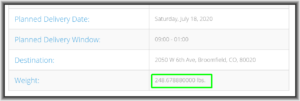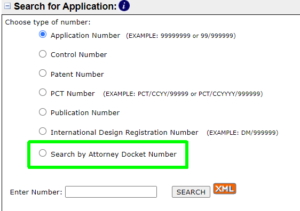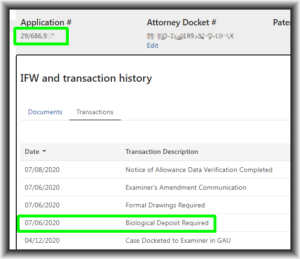
On about June 9, 2020, the USPTO quietly decided to accept more kinds of e-signatures in addition to the well-known “virgule” signature. Continue reading “USPTO quietly decides to accept more kinds of e-signatures”

On about June 9, 2020, the USPTO quietly decided to accept more kinds of e-signatures in addition to the well-known “virgule” signature. Continue reading “USPTO quietly decides to accept more kinds of e-signatures”

Today I went to a tracking page for Ikea’s delivery company and saw that the shipment weight was said to be “248.678880000 lbs.” This is, of course, impossible. The alert reader will perhaps already know where I am going with this. Why is this impossible? Continue reading “Illusory precision”
The executive summary here is that there are patent owners out there who are actually in possession of “walking corpses” instead of granted US patents … and the USPTO is doing a very customer-friendly thing and letting them know about the problem so that they can try to fix it prior to litigation time. The USPTO is to be commended on this. If you would like to more fully appreciate how very nice this is on USPTO’s part, read on.
Maybe you are in possession of such a “walking corpse” patent, and you don’t know it, and maybe the USPTO has not yet gotten around to letting you know it in your case. Maybe you should be trying to revive your own “walking corpse” patent. If so, then this blog article is for you.
Continue reading “USPTO doing a very customer-friendly thing (relating to walking corpses)”
What do I have in common with Robert De Niro? Continue reading “What I have in common with Robert De Niro”

Wikipedia offers a definition of “Easter egg” in the context of computer games:
While the term Easter egg has [historically] been used [simply] to mean a hidden object … it has come to be more commonly used to mean a message, image, or feature hidden in a video game, film, or other, usually electronic, medium. The term used in this manner was coined around 1979 by Steve Wright, the then Director of Software Development in the Atari Consumer Division, to describe a hidden message in the Atari video game Adventure.
In the world of computer games, Easter eggs are reason to smile. They are features, not bugs. The software developer who has tucked away an Easter egg or two (or a dozen or two Easter eggs) into a computer game is to be thanked for making life a bit more fun.
But in the context of a patent office e-commerce user interface, what is the meaning of “Easter egg”? Continue reading “What is an “Easter Egg”?”

One of the first questions that comes up any time any PAIR user tries to use Patentcenter for the first time is, how do you do a search by attorney docket number?
One of USPTO’s stated design goals for Patentcenter, from the outset, was that Patentcenter is supposed to replicate and enhance all of the functions and features of both EFS-Web and PAIR.
For most PAIR users, by far the single most frequently used function is “search by attorney docket number”. The moment that you log into PAIR, you see this function prominently in front of you. You do not have to hunt for it. The search itself requires only two mouse clicks, with no hunting or scrolling or required knowledge of Easter egg (hidden) locations in the user interface. See for example this Ideascale posting where a Patentcenter user writes:
There [is a feature] available in Private Pair, which [is] no longer available in Patent Center.
[It’s] no longer possible to search by docket number. This was useful, for example, when the system did not immediately find via application number.
As I say, this is by far the most frequently used single function in PAIR for most users. So one assumes the Patentcenter designers would (a) provide the same function, or better, and (b) make it just as easy to find, or easier to find.
No, no, no, and no. Continue reading “How do you search by attorney docket number in Patentcenter?”
Back in autumn of 2018, the alpha testers of Patentcenter told the Patentcenter developers, over and over again, please go and look at ePCT to see how they do it. Please look at the feature list for ePCT, said the alpha testers, and design your database structures so that you can implement the same features as in ePCT when the time comes.
It is now summer of 2020. Strikingly often, what we see is that twenty months later, a bug or missing feature that got reported to the USPTO in autumn of 2018 is still outstanding, and part of the bug report or missing feature report are words along the lines of “… and by the way a similar feature works correctly in ePCT.” Continue reading “If only the Patentcenter developers had looked at ePCT”
Some readers are aware of a struggle that is going on right now between a group of Patentcenter beta testers and the people at the USPTO who are in charge of the design of Patentcenter. The Patentcenter beta users comprise a listserv.
The Patentcenter beta testers point to many bugs and missing features in Patentcenter that have been broken and missing since autumn of 2018 when alpha testing of Patentcenter began. They ask USPTO to communicate with the listserv. USPTO has refused to communicate with the listserv. See blog article How should USPTO interact with its Patentcenter beta testers?
USPTO has repeatedly said that there is no need for it to communicate directly with the listserv because its original alpha tester and beta tester feedback mechanisms are supposedly more than adequate. The three original mechanisms are:
None of these mechanisms works even remotely well, from the point of view of the alpha testers and beta testers. I personally have reported many Patentcenter bugs to the EBC since the start of alpha testing in autumn of 2018, and not once did I ever hear back from the EBC about whether any bug got fixed or how a trouble ticket somehow got closed.
There had been a point a few weeks ago at which it seemed the USPTO was on the verge of making it possible to have some actual direct communication between USPTO’s Patentcenter developers and the listserv. Since then, unfortunately, I have not heard further from the USPTO. Meanwhile, the Trouble Report list maintained by the listserv continues to grow, and the Feature Request list maintained by the listserv continues to grow.
So the natural question that arises is, what might we as USPTO customers do to help the USPTO to understand that it is actually in the USPTO’s interest to make time to communicate directly with the listserv? I realized that one possibility is that maybe the USPTO decisionmakers do not fully appreciate the depth of failure of the original three mechanisms in terms of getting bugs fixed and getting missing features implemented. Maybe if USPTO were to see an itemised report, listing one by one in an objective fashion, the many dozens of Patentcenter missing feature reports that were reported to the USPTO from autumn of 2018 to the present, that USPTO failed to implement? Maybe if USPTO were to see an itemised report, listing one by one in an objective fashion the many dozens of Patentcenter bug reports that were reported to the USPTO from autumn of 2018 to the present, that USPTO failed to fix?
The report would review bug reports and missing-feature reports that had been posted to Ideascale by alpha testers during alphatest. This is not easy to do because the USPTO has deleted those postings from public view — who can say why? I sent a FOIA request to USPTO and received a copy of all of my own alpha tester postings to Ideascale. If I were to make the time for it, I could work my way through the 75 pages of that document and itemize things. and generate some sort of report showing just how much of a failure the Ideascale mechanism has been in terms of getting Patentcenter bugs fixed and getting missing features implemented over the past 20 months. (You can see the 75-page FOIA response here.)
The other thing would be to review all of the Patentcenter alpha test and beta test problems that I reported to the EBC from autumn 2018 to the present. I have reported dozens of bugs to the EBC. EBC opened many trouble tickets. Not once has anybody from the EBC gotten back to me in response to even one of those trouble tickets. I made a FOIA request to the USPTO asking for documents indicative of the Patentcenter trouble reports that I reported to the EBC from autumn 2018 to now, and documents indicative of how the USPTO somehow closed those tickets or otherwise addressed them. I heard back from the USPTO FOIA office that if I want these documents, I will have to send them a check for $833.40. You can see the letter here. I’ve just sent them the check and I am looking forward to seeing the results, which I suppose will show up in a couple of weeks. If I were to make the time for it, I could work my way through those documents as well, after they arrive, generating some sort of report showing just how much of a failure the report-to-EBC mechanism has been in terms of getting Patentcenter bugs fixed and getting missing features implemented over the past 20 months.
But imagine a different next few weeks or months. Imagine a future in which the Patentcenter developers, in a reversal of the previous digging-in of heels, might actually choose to communicate directly with the listserv. This would permit my energies to go toward a goal shared by the USPTO and by the listserv — making Patentcenter better. I would much rather direct my energies that way, rather than directing my energies toward generating detailed objective reports showing the extent of failure of the old communications paths.
The USPTO is developing its Patentcenter system which it intends will eventually replace EFS-Web and PAIR. Eventually USPTO plans to shut down EFS-Web and PAIR and the only way that customers of the USPTO will be able to accomplish the functions formerly carried out through EFS-Web and PAIR will be by means of Patentcenter. From the outset, USPTO has said that one of its stated requirements for Patentcenter is that it must offer at least all of the functions of EFS-Web and PAIR.
Patentcenter is not yet released from beta test, and rightfully so, given that many features of EFS-Web and PAIR are not yet implemented in Patentcenter, and given that many things in Patentcenter do not work correctly or do not work at all. (See Patentcenter Trouble Tickets and Patentcenter Feature Requests.) During beta test, a natural question is, in what way or what ways should the people at the USPTO who are responsible for developing Patentcenter interact with those beta testers?
The USPTO has made clear that it feels it should not have to respond in any direct way to any of the beta testers when they report bugs or missing features. Continue reading “How should USPTO interact with its Patentcenter beta testers?”

Here’s a nice thing to smile about over your morning caffeine fix.
Like many loyal readers of this blog, we at OPLF check the status of our cases in Patentcenter (or, in the old days, in PAIR) every day or so on general principles. It lets us know for example if an Office Action is imminent or if an Allowance is imminent.
Just now our daily status check revealed this case in our docket, in which the status is “allowed, Notice of Allowance not yet mailed”. This means the Examiner has allowed the case, but we have not yet received the Notice of Allowance. So let’s see how alert you are at this time of the morning. What’s very much out of the ordinary about this transaction history in this “allowed case”? Well, the answer is in the title of the blog post, so you probably already knew where I was going with this one. Continue reading “A Budapest Treaty deposit requirement in an industrial design case!?”